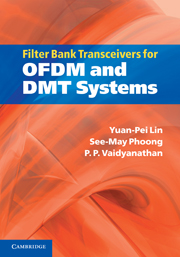Book contents
- Frontmatter
- Dedication
- Contents
- Preface
- 1 Introduction
- 2 Preliminaries of digital communications
- 3 FIR equalizers
- 4 Fundamentals of multirate signal processing
- 5 Multirate formulation of communication systems
- 6 DFT-based transceivers
- 7 Precoded OFDM systems
- 8 Transceiver design with channel information at the transmitter
- 9 DMT systems with improved frequency characteristics
- 10 Minimum redundancy FIR transceivers
- A Mathematical tools
- B Review of random processes
- References
- Index
9 - DMT systems with improved frequency characteristics
Published online by Cambridge University Press: 05 August 2015
- Frontmatter
- Dedication
- Contents
- Preface
- 1 Introduction
- 2 Preliminaries of digital communications
- 3 FIR equalizers
- 4 Fundamentals of multirate signal processing
- 5 Multirate formulation of communication systems
- 6 DFT-based transceivers
- 7 Precoded OFDM systems
- 8 Transceiver design with channel information at the transmitter
- 9 DMT systems with improved frequency characteristics
- 10 Minimum redundancy FIR transceivers
- A Mathematical tools
- B Review of random processes
- References
- Index
Summary
The topic of frequency responses of the transmitting and receiving filters has not come into our earlier discussions of transceiver design. The frequency characteristics of the filters are also an important aspect of transceiver designs. The stopband attenuation of the transmitting (receiving) filters determines how well separated the subchannels are in the frequency domain at the transmitter (receiver). Frequency separation at the transmitter side is important for the control of spectral leakage, i.e. undesired out-of-band spectral components. Poor separation will lead to significant spectral leakage. This could pose a problem in applications where the power spectrum of the transmitted signal is required to have a large rolloff in certain frequency bands. Wired applications with frequency division multiplexing, e.g. ADSL and VDSL, are such examples [7, 8]. The power spectrum of the transmitted signal should be properly attenuated in the transmission bands of the opposite direction to avoid interference. The power spectrum should also be attenuated in amateur radio bands to reduce interference to radio transmission, called egress emission [8]. On the other hand, poor frequency separation at the receiver side results in poor out-of-band rejection. In ADSL and VDSL applications. some of the frequency bands are also used by radio transmission systems such as amplitude-modulation stations and amateur radio. The radio frequency signals can be coupled into the wires and this introduces radio frequency interference (RFI) or ingress [29]. Poor frequency selectivity of the receiving filters means many neighboring tones can be affected. The signal to interference noise ratios of these tones are reduced and the total transmission rate decreased.
We found in Chapter 6 that in the DMT transceiver the transmitting and receiving filters come from rectangular windows. The spectral sidelobes of these filters are often inadequate to provide sufficient subchannel separation. In this chapter, we will use a filter bank approach to improving frequency separation among subchannels. Based on the filter bank representation of the DMT transceiver, we will introduce what we call subfilters in the subchannels.
- Type
- Chapter
- Information
- Filter Bank Transceivers for OFDM and DMT Systems , pp. 259 - 290Publisher: Cambridge University PressPrint publication year: 2010



